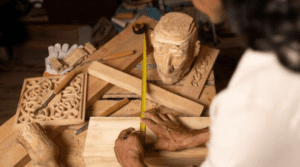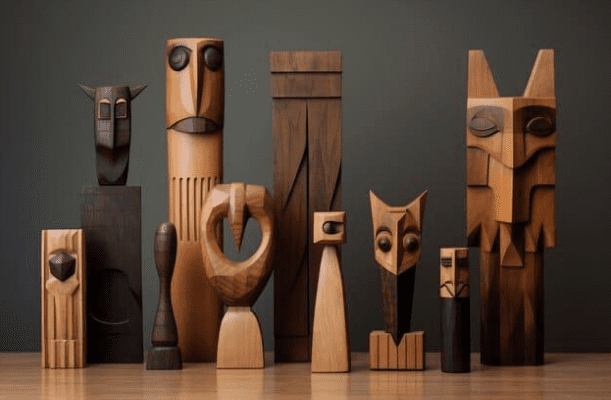Wood Carving Figures: A Guide for Beginners
Wood sculpturing numbers are a great way to explore your creativity in Wood Carving Figures, whether you are interested in casting naturalistic beast puppets or capricious characters. The process involves shaping wood using sharp tools to produce intricate or simple designs. It can be done by anyone, with practice and the right tools, making it a pleasurable and satisfying hobbyhorse for people of all periods.
The History of Wood sculpturing
The art of wood figure has been rehearsed by colorful societies throughout history. From religious numbers to ornamental art, wood has been a favored medium due to its vacuity and versatility. Ancient societies, similar as the Egyptians, Mayans, and Greeks, used wood to draft everything from tools to puppets. Indeed, at the moment, wood figure continues to evolve, blending traditional styles with ultramodern cultural expressions.

Why Choose Wood sculpturing as a Hobby?
Wood sculpturing offers multitudinous benefits, from relaxation to tone-expression. It’s a hands-on exertion that allows you to produce palpable pieces of art, whether for particular enjoyment or as gifts. Plus, the wood figure is a fairly affordable hobbyhorse once you have your introductory tools. It can also be pensive, allowing you to concentrate on creating while forgetting the stresses of diurnal life.
Types of Wood sculpturing
There are colorful styles of wood figure, each taking different ways and tools. Let’s take a near look at some of the most popular types.
Whittling
Whittling is maybe the most introductory form of wood figure. It involves using a small cutter to sculpt down at a piece of wood. Whittling is frequently done with soft forestland like basswood, and it’s an excellent entry point for newcomers.
Relief sculpturing
Relief figure involves sculpturing numbers into a flat piece of wood, creating a raised design. This style is frequently used for signs, pillars, or ornamental panels. It requires precise control and an understanding of depth to produce realistic images.
Chip sculpturing
In chip figure, small chips of wood are removed to produce intricate patterns and designs. It’s generally used for ornamental purposes, similar as adorning cabinetwork or creating ornate boxes. Chip figure shanks are especially designed for this task.
Sculpturing in the Round
This style of figure involves creating completely three-dimensional numbers. These wood sculpturing numbers can range from simple creatures to largely detailed mortal numbers. Sculpturing in the round requires a good understanding of form and depth.
Essential Tools for Wood sculpturing
To produce beautiful wood sculpturing numbers and Wood Carving Figures, you’ll need the right tools. Then is a breakdown of the rudiments.
Sculpturing shanks
A sharp figure cutter is the utmost introductory tool every woodcarver requires. It’s protean enough to handle colorful types of wood, and it allows for detailed work.
Ruptures and Chisels
These tools are used for removing larger gobbets of wood and shaping the figure. Ruptures have twisted edges, making them perfect for creating smooth angles, while chisels are flat and are stylish for straight cuts.
Mallet
A mallet is used to tap chisels when you require further force to remove wood. It provides control and perfection when sculpturing harder forestland.
Sandpaper
Once your figure is sculpted, you’ll need to smooth the face using sandpaper. Fine-fortitude sandpaper helps achieve a polished finish, giving your wood sculpturing figure a professional look.

Stylish Wood for sculpturing numbers
Choosing the right wood is pivotal when it comes to wood figure. Different forestland have different textures and situations of hardness, which will affect how easy or delicate they’re to sculpt. Some stylish forestland for sculpturing includes.
Basswood
Basswood is one of the most popular forestland for sculpturing due to its riskiness and fine grain. It’s easy to sculpt and is a great option for newcomers.
Butternut
analogous to basswood, butternut is soft and easy to sculpt. It has a beautiful light brown color, making it ideal for uncolored numbers.
Oak
Oak is a harder wood, which makes it more grueling to sculpt but perfect for creating durable, long- lasting puppets.
Pine
Pine is a softwood that is generally used for figure. Its vacuity and low cost make it a popular choice for newcomers, though it can occasionally be prone to splitting.
Choosing the Right Wood for Your design
The type of wood you choose will depend on the complexity of the figure you want to sculpt. For intricate designs with lots of detail, softer forestland like basswood or butternut are ideal. For further durable systems or large numbers, you might conclude for harder forestland like oak.
Introductory ways for Wood sculpturing numbers
sculpturing wood requires skill and perfection, but with practice, anyone can master the introductory ways.
Understanding Grain Direction
One of the most important effects to learn when sculpturing wood is how to work with the grain. Cutting with the grain will make your figure easier and help you avoid splits or breaks.
Proper Hand Positioning
Proper hand positioning ensures safety and control. Always sculpt down from your body and keep your hands out of the tool’s path.
Sculpturing Small Details
When it comes to sculpturing details, take your time. Use lower, more controlled strokes and a sharp cutter to sculpt intricate areas like facial features or textures on beast fur.
How to Start Your First Wood sculpturing Figure
For newcomers, starting with a simple design can help make your chops and confidence. Then’s how to begin
Sketching the Design
Before you begin sculpturing, it’s helpful to have a clear design in mind. You can either sketch directly onto the wood or use a separate delineation to guide your figure.
Transferring the Design to Wood
Use a pencil to transfer your design onto the piece of wood. This will serve as your companion as you start removing material.
Safety Tips for Wood sculpturing
Wood figure can be a safe hobbyhorse if you follow some introductory preventives
- Always sculpt down from your body.
- Keep your tools sharp — dull tools can slip and beget injury.
- Wear gloves designed for wood figure to cover your hands.

Step-by- Step companion to sculpturing a Simple Beast Figure
Now, let’s walk through the process of sculpturing a simple beast figure, similar as a raspberry
- Choose your wood – Basswood is great for this design.
- Draw your raspberry – figure the shape of the raspberry on the wood.
- Start figure – Begin by removing large sections of wood, sluggishly enriching the shape.
- Add details – Use lower tools to sculpt the eyes, beak, and feathers.
- Beach the figure – Smooth the face to prepare it for finishing.
Finishing Touches Sanding and Polishing
Once you’ve sculpted your figure, the finishing traces can make all the difference. Start by grinding the figure with fine-fortitude sandpaper. After that, you can either leave the wood natural or apply a finish similar as oil painting or wax to give it a polished look.
Oil and Staining Your Wood sculpturing numbers
For added faculty, you might want to paint or stain your wood sculpturing numbers. Tempera paints work well on wood, allowing you to add details like fur patterns or facial features. Alternately, wood stains can enhance the natural grain of the wood while giving it a rich, finished look.
Common miscalculations to Avoid in Wood sculpturing
When sculpturing wood, there are a many common miscalculations that newcomers should watch out for
- Using dull tools – Always keep your tools sharp.
- Rushing – Wood sculpturing requires tolerance; rushing through a design can lead to miscalculations.
- Ignoring the grain – Always pay attention to the direction of the grain when making cuts.
Conclusion
Wood sculpturing numbers is a fulfilling and accessible hobbyhorse that allows you to produce unique, hand wrought pieces. Whether you’re just starting or looking to upgrade your chops, this companion provides all the introductory knowledge you need to begin your trip. With practice, tolerance, and the right tools, you’ll be casting beautiful wood sculpturing numbers in no time.
FAQs about Wood sculpturing numbers
- What’s the stylish wood for newcomers in wood figure?
- Basswood is an excellent choice for newcomers due to its lumpiness and ease of figure.
- How long does it take to sculpt a small figure?
- Depending on the complexity of the design, a small figure can take anywhere from a many hours to a many days to complete.
- Do I need to be cultural to start wood figure?
- While cultural chops can help, they are not necessary. Wood figure is about practice and developing your fashion over time.
- Can I use regular shanks for wood figure?
- It’s better to use technical figure shanks as they’re designed for perfection and safety.
- Is wood sculpturing precious to start?
- Not at all! After the original investment in tools, a wood figure can be a veritably affordable hobbyhorse.
